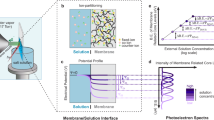Summary
The thermodynamic formulation of isotope interaction (coupling of abundant and tracer isotope flows) has been tested in a highly permselective anion exchange membrane in the absence of significant electroosmosis. A previous study of Cl− permeation has now been extended to include permeation of I−, Acetate, and SO 2−4 in different bath concentrations, with the use of both electrical and chemical driving forces. The flux ratios were “abnormal” according to the usual criteria for simple passive flow, but were closely predicted by the theoretical expression incorporating the influence of isotope interaction. In the absence of coupled flows of other chemical species the extent of isotope interaction can be determined either from the flux ratio or from the measurement of a single unidirectional flux at two settings of the electrochemical potential difference. Direct evidence of negative isotope interaction was presented.
Similar content being viewed by others
References
DeSousa, R. C., Li, J. H., Essig, A. 1971. Flux ratios and isotope interaction in an ion exchange membrane.Nature 231:44
Gottlieb, M. H., Neihof, R., Sollner, K. 1957. Preparation and properties of strong base collodion matrix membranes.J. Phys. Chem. 61:154
Gottlieb, M. H., Sollner, K. 1968. Failure of the Nernst-Einstein equation to correlate electrical resistances and rates of ionic self-exchange across certain fixed charge membranes.Biophys. J. 8:515
Hodgkin, A. L., Keynes, R. D. 1955. The potassium permeability of a giant nerve fiber.J. Physiol. 128:61
Kedem, O., Essig, A. 1965. Isotope flows and flux ratios in biological membranes.J. Gen. Physiol. 48:1047
McHardy, W. J., Meares, P., Sutton, A. H., Thain, J. F. 1969. Electrical transport phenomena in a cation-exchange membrane. II. Conductance and electroosmosis.J. Colloid Interface Sci. 29:116
Meares, P., Dawson, D. G., Sutton, A. H., Thain, J. F. 1967. Diffusion, conduction and convection in synthetic polymer membranes.Ber. Bunsenges. 71:765
Meares, P., Sutton, A. H. 1968. Electrical transport phenomena in a cation-exchange membrane. I. The determination of transport numbers and the ratios of tracer fluxes.J. Colloid Interface Sci. 28:118
Saito, T., Essig, A. 1973. Effect of aldosterone on active and passive conductance andE Na in the toad bladder.J. Membrane Biol. 13:1
Saito, T., Lief, P. D., Essig, A. 1974. Conductance of active and passive pathways in the toad bladder.Amer. J. Physiol. 226:1265
Ussing, H. H. 1947. Interpretation of the exchange of radio-sodium in isolated muscle.Nature 160:262
Ussing, H. H. 1960. The Alkali Metal Ions in Biology. Springer-Verlag, Berlin
Author information
Authors and Affiliations
Rights and permissions
About this article
Cite this article
Li, J.H., DeSousa, R.C. & Essig, A. Kinetics of tracer flows and isotope interaction in an ion exchange membrane. J. Membrain Biol. 19, 93–104 (1974). https://doi.org/10.1007/BF01869972
Received:
Revised:
Issue Date:
DOI: https://doi.org/10.1007/BF01869972




